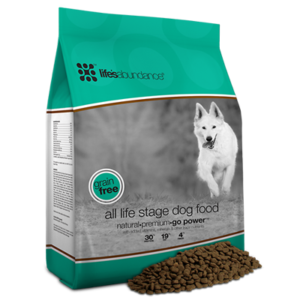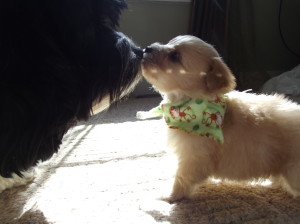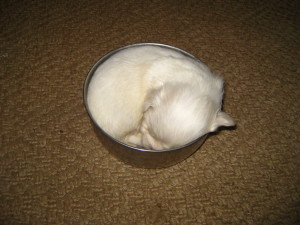Click here to order your Life’s Abundance dog food!
Make sure it is the grain free all life stages.

One of the many reasons I like Life’s Abundance is because it has never been recalled. Many many of the other dog foods have been recalled and have even caused death. To me, a company only get’s one chance.
The list of recalled dog foods also includes some holistic dog foods.
If you named the food you were using, trust me, it was recalled at some point. Do a google search on your food and see. If it was recalled even a few years ago, I would not use it, I would not trust the company.
Read this article about Blue Buffalo. Apparently, they have been lying about ingredients in their food and they got caught.
*****Make sure it is the Grain Free All Life Stages food that you order.
They have really nice Training Treats, links are above. or you can just make them yourself. I have a really nice kit for you to do that. Puppies and dogs seem to love both!
This page is about the food you feed your pets.
Which food are you using? How can you tell which one is best? You may think you are using the best, but are you? Could your dog be healthier with a different dog food? Could he have lived longer? Keep reading and see what you think!
“Do you know what is in meat meal, the major constituent of dry dog food? Urine, fecal matter, hair, pus, meat (from animals, afflicted) with cancer.” Wendell O. Belfield, DVM
I use Life’s Abundance. This is what your puppy is on when you take him home and he will need to stay on it for at least 1 year, just because a switch at this young age is not good for his little digestive system and he will get loose stools. A large breed would handle the dietary change just fine but not a small breed.
This needs to be ordered through my website, that way I will know when you have ordered it. They send me an email of each order. PLUS, believe it or not, they charge me $10.00 a month to sell their food and $120.00 a year to use their website to sell it. You would think they would be happy that I recommended their food, but no.
Regardless of their business practices I still recommend it because it is a wonderful dog food. I also recommend that your puppy stays on it for his entire life as I think that would be the healthiest thing for him to eat. I think it is one of the reasons my puppies have such nice coats.
Even though I do strongly suggest this particular dog food and say it is the best, it really isn’t the best thing for your puppy.
We actually do a raw food for your puppy when he is just starting to get introduced to food. The recipe was formulated by a holistic vet and we have been using it for many years. If you would like the recipe, just ask me.
If you have already picked out your puppy and have a deposit on him, if you would like me to NOT transition him to Life’s Abundance, I can do that for you. You would just have to make sure you have everything set to go when you bring him home, as far as the homemade food goes.
I have had quite a few customers do this, it really is the best thing to do, with Life’s Abundance being second best.
If I have already transitioned your dog to Life’s Abundance and you would like to do the homemade, you would just need to transition him slowly to the homemade. I will help you! I feel it is my job to help you do your very best to help your puppy!
“The results of a clinical trial suggest that 74.7% of common diseases in dogs and 63% of common diseases in cats can be eliminated without medical intervention over a period of one year with proper diet modifications and an understanding of the healing process as exhibited through healing episodes. Approaching disease from the perspective of health is the most powerful means of eliminating disease. Poor fuel makes for little momentum in life.” William Pollak, DVM
“Eating supermarket pet foods is like eating cardboard. Our pets just get by on them and the foods lack any real vitality for the flourishing of health. Life is designed to be lived in vitality; surviving is living a slow death even before departure from the body.”
When you take your puppy home, you will need to feed him 4 times a day or just leave the food out.
I like leaving the food out so he can eat whenever he wants.
Puppies are to eat as much food as they want, no matter what it says on the bag of food. I rarely find that the small breed dogs overeat and get fat.
This is not a dog food you can find in a store but the company does deliver it, which I love!
They have a wonderful dog food! I would order the 8 lb bag and get put on auto ship. Although, for an even greater savings, you could order the 20 lb bag. Their prices are right in line with the dog food prices for the higher end dog foods found in the stores.
Sometimes you get the dog food in 1-2 days. The holidays and weekends change that of course. They are closed Saturday and Sunday.
***Your puppy will need his (hard) food soaked in water
to soften it until he is about 6 months old.
He needs a lot of teeth to really chew it good.
Given the choice, your puppy would choose the hard food over the soft food, but that doesn’t mean you should give it to him.
My grand children would prefer ice cream for dinner too,
but it doesn’t mean they get it.
(Okay, once in awhile!)
Many puppies have ripped their esophagus or choked and died from eating the hard food. They simply do not have enough teeth to chew it good.
Part of the problem is young puppies can really dive into their food.
They get very hungry because they are doing so much growing.
Get The Facts: What’s Really in Pet Food
Plump whole chickens, choice cuts of beef, fresh grains, and all the wholesome nutrition your dog or cat will ever need.
These are the images pet food manufacturers promulgate through the media and advertising. This is what the $16.1 billion per year U.S. pet food industry wants consumers to believe they are buying when they purchase their products.
This report explores the differences between what consumers think
they are buying and what they are actually getting.
It focuses in very general terms on the most visible name brands
the pet food labels that are mass-distributed to supermarkets and
discount stores but there are many highly respected brands that may be guilty of the same offenses.
What most consumers don’t know is that the pet food industry is an
extension of the human food and agriculture industries.
Pet food provides a convenient way for slaughterhouse offal,
grains considered unfit for human consumption, and
similar waste products to be turned into profit.
This waste includes intestines, udders, heads, hooves, and
possibly diseased and cancerous animal parts.
There is no choice to be made as to which dog food to put your puppy on. It is very important that he stays on the same dog food
since a change can cause loose stools and can quickly lead to hypoglycemia.
Hypoglycemia in a puppy can be deadly.
Staying on the same dog food is so important that I
put it in my Puppy Guarantee that your puppy
must stay on this dog food for at least 1 year.
If you are choosing to go the homemade route, then I will alter my guarantee for you.
The Players
The pet food market has been dominated in the last few years by the acquisition of big companies by even bigger companies.
With $15 billion a year at stake in the U.S. and rapidly expanding foreign markets, it’s no wonder that some are greedy for a larger piece of the pie.
* Nestle’s bought Purina to form Nestle Purina Petcare Company (Fancy Feast, Alpo, Friskies, Mighty Dog, Dog Chow, Cat Chow, Puppy Chow, Kitten Chow, Beneful, One, ProPlan, DeliCat, HiPro, Kit’n Kaboodle, Tender Vittles, Purina Veterinary Diets).
* Del Monte gobbled up Heinz (MeowMix, Gravy Train, Kibbles ‘n Bits, Wagwells, 9Lives, Cycle, Skippy, Nature’s Recipe, and pet treats Milk Bone, Pup-Peroni, Snausages, Pounce).
* MasterFoods owns Mars, Inc., which consumed Royal Canin (Pedigree, Walthams, Cesar, Sheba, Temptations, Goodlife Recipe, Sensible Choice, Excel).
Other major pet food makers are not best known for pet care, although many of their household and personal care products do use ingredients derived from animal by-products:
* Procter and Gamble (P& G) purchased The Iams Company (Iams, Eukanuba) in 1999. P& G shortly thereafter introduced Iams into grocery stores, where it did very well.
* Colgate-Palmolive bought Hills Science Diet (founded in 1939) in 1976
(Hills Science Diet, Prescription Diets, Nature’s Best).
Private labelers (who make food for house brands like Kroger and WalMart) and co-packers (who produce food for other pet food makers) are also major players.
Three major companies are Doane Pet Care, Diamond, and Menu Foods;
they produce food for dozens of private label and brand names.
Interestingly, all 3 of these companies have been involved in
pet food recalls that sickened or killed many pets.
Many major pet food companies in the United States are subsidiaries
of gigantic multinational corporations.
From a business standpoint, pet food fits very well with companies
making human products.
The multinationals have increased bulk-purchasing power;
those that make human food products have a captive market in which
to capitalize on their waste products; and pet food divisions have a more reliable capital base and, in many cases, a convenient source of ingredients.
The Pet Food Institute & the trade association of pet food manufacturers
has acknowledged the use of by-products in pet foods as additional income for processors and farmers:
The growth of the pet food industry not only provided pet owners with better foods for their pets, but also created profitable additional markets for American farm products and for the byproducts of the meat packing, poultry, and other food industries which prepare food for human consumption.
The Manufacturing Process: How Pet Food Is Made
Dry Food
The vast majority of dry food is made with a machine called an extruder.
First, materials are blended in accordance with a recipe created
with the help of computer programs that provide the
nutrient content of each proposed ingredient.
For instance, corn gluten meal has more protein than wheat flour.
Because the extruder needs a consistent amount of starch and low moisture to work properly, dry ingredients such as rendered meat-and-bone-meal, poultry by-product meal, grains, and flours predominate.
The dough is fed into the screws of an extruder. It is subjected to steam and high pressure as it is pushed through dies that determine the shape of the final product, much like the nozzles used in cake decorating.
As the hot, pressurized dough exits the extruder, it is cut by a set of rapidly whirling knives into tiny pieces. As the dough reaches normal air pressure, it expands or puffs into its final shape.
The food is allowed to dry, and then is usually sprayed with fat,
digests, or other compounds to make it more palatable.
When it is cooled, it can be bagged.
A few dog foods are baked at high temperatures (over 500) rather than extruded. This produces a sheet of dense, crunchy material that is then broken into irregular chunks, much like crumbling crackers into soup.
It is relatively palatable without the sprayed-on fats and other enhancers needed on extruded dry food.
Semi-moist foods and many pet treats are also made with an extruder.
To be appealing to consumers and to keep their texture, they contain many additives, colorings, and preservatives; they are not a good choice for a pet’s primary diet.
Wet Food
Wet or canned food begins with ground ingredients mixed with additives.
If chunks are required, a special extruder forms them. Then the mixture is cooked and canned.
The sealed cans are then put into containers resembling pressure cookers and commercial sterilization takes place. Some manufacturers cook the food right in the can.
Wet foods are quite different in content from dry or semi-moist foods.
While many canned foods contain by-products of various sorts, they are fresh and not rendered or processed (although they are often frozen for transport and storage).
Wet foods usually contain much more protein, and it’s often a little higher quality, than dry foods. They also have more moisture, which is better for cats. They are packaged in cans or pouches.
Comparing Food Types
Because of the variation in water content, it is impossible to directly compare labels from different kinds of food without a mathematical conversion to dry matter basis.
The numbers can be very deceiving.
For instance, a canned food containing 10% protein actually has
much more protein than a dry food with 30% protein.
To put the foods on a level playing field, first calculate the dry matter content by subtracting the moisture content given on the label from 100%. Then divide the ingredient by the dry matter content.
For example, a typical bag of dry cat food contains 30% protein on the label, but 32% on a dry-matter basis (30% divided by its dry matter content, 100-6% moisture = 94%).
A can of cat food might contain 12% protein on the label, but almost 43% on a dry-matter basis (12% divided by its dry matter content, 100-72% moisture = 28%).
Dry food typically contains less than 10% water, while canned food contains 78% or more water.
Dog Food Ingredients
Animal Protein
Dogs and cats are carnivores, and do best on a meat-based diet.
The protein used in pet food comes from a variety of sources.
When cattle, swine, chickens, lambs, or other animals are slaughtered,
lean muscle tissue is trimmed away from the carcass for human consumption,
along with the few organs that people like to eat, such as tongues and tripe.
However, about 50% of every food animal does not get used in human foods.
Whatever remains of the carcass — heads, feet, bones, blood, intestines, lungs, spleens,
livers, ligaments, fat trimmings, unborn babies, and other parts not generally consumed by humans —
is used in pet food, animal feed, fertilizer, industrial lubricants, soap, rubber, and other products.
These “other parts” are known as “by-products.”
By-products are used in feed for poultry and livestock as well as in pet food.
The nutritional quality of by-products, meals, and digests can vary from batch to batch.
James Morris and Quinton Rogers, of the University of California at Davis Veterinary School, assert that,
“[pet food] ingredients are generally by-products of the meat, poultry and fishing industries,
with the potential for a wide variation in nutrient composition.
Claims of nutritional adequacy of pet foods based on the current
Association of American Feed Control Officials (AAFCO) nutrient allowances (‘profiles’)
do not give assurances of nutritional adequacy and
will not until ingredients are analyzed and bioavailability values are incorporated.”3
Meat or poultry “by-products” are very common in wet pet foods.
Remember that “meat” refers to only cows, swine, sheep, and goats.
Since sheep and goats are rare compared to the 37 million cows and 100 million hogs
slaughtered for food every year, nearly all meat by-products come from cattle and pigs.
The better brands of pet food, such as many “super-premium,” “natural,”
and “organic” varieties, do not use by-products.
On the label, you’ll see one or more named meats among the first few ingredients,
such as “turkey” or “lamb.”
These meats are still mainly leftover scraps;
in the case of poultry, bones are allowed, so “chicken” consists mainly of backs and frames–
the spine and ribs, minus their expensive breast meat.
The small amount of meat left on the bones is the meat in the pet food.
Even with this less-attractive source, pet food marketers are very tricky
when talking about meat, so this is explained further in the section on “Marketing Magic” below.
Meat meals, poultry meals, by-product meals, and meat-and-bone meal
are common ingredients in dry pet foods.
The term “meal” means that these materials are not used fresh, but have been rendered.
While there are chicken, turkey, and poultry by-product meals there is no equivalent term for mammal
“meat by-product meal” — it is called “meat-and-bone-meal.”
It may also be referred to by species, such as “beef-and-bone-meal” or “pork-and-bone-meal.”
What is rendering?
As defined by Webster’s Dictionary, to render is “to process as for industrial use: to render
livestock carcasses and to extract oil from fat, blubber, etc., by melting.”
In other words, raw materials are dumped into large vat and boiled for several hours.
Rendering separates fat, removes water, and kills bacteria, viruses, parasites, and other organisms.
However, the high temperatures used (270°F/130°C)
can alter or destroy natural enzymes and proteins found in the raw ingredients.
Because of persistent rumors that rendered by-products contain dead dogs and cats,
the FDA conducted a study looking for pentobarbital,
the most common euthanasia drug, in pet foods.
They found it.
Ingredients that were most commonly associated with the presence of pentobarbital
were meat-and-bone-meal and animal fat.
However, they also used very sensitive tests to look for canine and feline DNA,
which were not found.
Industry insiders admit that rendered pets and roadkill were
used in pet food some years ago.
Although there are still no laws or regulations against it, the practice is uncommon today,
and pet food companies universally deny that their products contain any such materials.
However, so-called “4D” animals (dead, dying, diseased, disabled)
were only recently banned for human consumption and are still legitimate ingredients for pet food.










